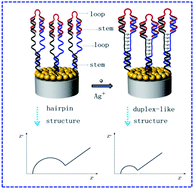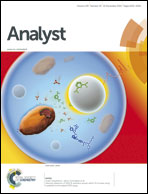Sensitive impedimetric biosensor based on duplex-like DNA scaffolds and ordered mesoporous carbon nitride for silver(i) ion detection†
Abstract
This study demonstrates a new, unlabeled immobilized DNA-based biosensor with ordered mesoporous carbon nitride material (MCN) for the detection of Ag+ by electrochemical impedance spectroscopy (EIS) with [Fe(CN)6]4−/3− as the redox couple. The unlabeled immobilized DNA initially formed the hairpin-like structure through hybridization with the probe, and then changed to duplex-like structure upon interaction with Ag+ in solution to form a C–Ag+–C complex at electrode surface. As a result, the interfacial charge-transfer resistance of the electrode towards the [Fe(CN)6]4−/3− redox couple was changed. Thus, a declined charge transfer resistance (Rct) was obtained, corresponding to Ag+ concentration. MCN provide an excellent platform for DNA immobilization and faster electron transfer. Impedance data were analyzed with the help of Randles equivalent circuit. The lower detection limit of the biosensor for Ag+ is 5 × 10−11 M with good specificity. All results showed that this novel approach provides a reliable method for Ag+ detection with sensitivity and specificity, potentially useful for practical applications. Moreover, other DNA detection methods for more heavy metals may be obtained from this idea and applied in the environmental field.


 Please wait while we load your content...
Please wait while we load your content...